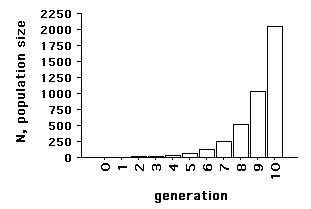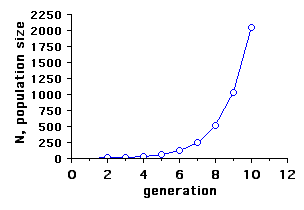

| Dept of Biology, Lewis and Clark College | Dr Kenneth Clifton
|
|
Biology
141 Lecture Outline
|
Introduction to population ecology.
What is a population and why are we interested in them, generally?
Why do ecologists study populations?
Environmental issues:
The size of the human population is responsible for virtually all of the planet's environmental problems.
Predicting the future:
Forecasting population trends is of interest, especially for species that have relevance for human life (for example, harvested species, pest species, game species, endangered species).
Learning about how populations behave:
We'd like to understand the reasons behind population trends (and then we might study species because they are easy- to-study "models" rather than because of their specific importance).
How do we study populations?
Where are individuals?
How many of them are there?
Who are they?
Focus on a particular species and collect information about it, or...
Build a model.
What is a model?
What scientific models have in common with more mundane models:
models are simplified representations of complex phenomena that aim to identify the essential details.
Mathematical models -- even if you don't know how to generate an equation, you should know what their terms mean, what their conclusions are, and why they are useful.
Models of population growth
Define terms.
N = number of individuals in a population now.
Nx= number of individuals in a population x time units from now.
How can we forecast how a population's size will change over time?
Consider a model of non-overlapping generations using difference equations.
A hypothetical, simple situation: N = 2. At end of each year, all adults die right after they have reproduced. Each couple makes 4 offspring.
How big will this population be in 100 yrs?
Thinking through the problem, then building a model to represent our reasoning.
NT = N0 x RT
where R = the factor by which the population changes its size every time period.
T is a measure of time, expressed in terms of generations
How do you calculate R?
Next: A model with overlapping generations, using differential equations, births and deaths not restricted to a single moment in time
Define terms:
b, per-capita birth rate (note: rate not equal to number).
d, per-capita death rate.
r = (b-d) = rate of change of population size, or a population's intrinsic rate of increase.
a new model: dN/dt = rN0. (note the "d" here is short hand for "very small change" and not the "d" signifying death rate)
to use the model to make forecasts, integrate it to get...? click here to see the integration step-by-step
Predictions of both models: explosive exponential growth of the population.
 |
 |
Comparing a models' predictions with data: how accurate are they?
Does this reflect actual populations, or have we forgotten something?